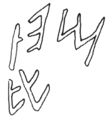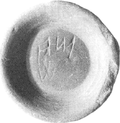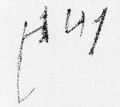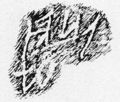CO·14
| Inscription | |
|---|---|
| Reading in transliteration: | mẹi / ṿạ |
| Reading in original script: | |
|
| |
| Object: | CO·14 Rondineto (unidentifiable) |
| Position: | foot, outside |
| Direction of writing: | sinistroverse |
| Script: | North Italic script (Lepontic alphabet) |
| Letter height: | 0.7–1.3 cm0.276 in <br />0.512 in <br /> |
| Number of letters: | 5 |
| Number of lines: | 2 |
| Workmanship: | scratched after firing |
| Condition: | complete |
|
| |
| Archaeological culture: | Golasecca III A [from object] |
| Date of inscription: | 5th–early 4th c. BC [from object] |
|
| |
| Type: | unknown |
| Language: | perhaps Celtic |
| Meaning: | unknown |
|
| |
| Alternative sigla: | Whatmough 1933 (PID): 296 Solinas 1995: 87 Morandi 2004: 161 |
|
| |
| Sources: | Morandi 2004: 629 f. |
Images
Commentary
First published in Garovaglio 1883: 20, no. 1.
Images in Garovaglio 1883: fig. 1 (drawing = Tibiletti Bruno 1969b: 285, tav. XIII.28a), Rhŷs 1914: pl. II (photo), Tibiletti Bruno 1969b: 285, tav. XIII.28b (tracing), Solinas 1995: 354 (drawing), Morandi 1999: 179 (drawing = Morandi 2004: 628, fig. 20.161) and 202, tav. XV.1 (photo = Morandi 2004: 800, tav. XXIII.161).
Two groups/lines of letters inscribed on the outside foot of the vessel. In the longer line (2 cm), mu is very clear. The next letter is a hasta with two clear bars ![]() and another potential damaged and not quite parallel bar underneath; then a single hasta. The shorter line (0.9 cm) consists of two slightly smaller letters, both in the shape
and another potential damaged and not quite parallel bar underneath; then a single hasta. The shorter line (0.9 cm) consists of two slightly smaller letters, both in the shape ![]() .
.
The inscription was seen in the museum by Rhŷs 1913: 39, III.1.2, who read two words written sinistroverse in false boustrophedon piuai | aa 'Aa for Biua' (also Rhŷs 1913: 8 f.). Whatmough PID: 102, no. 296 read p·nại | aḷ, yet again with a "certain" surprise punct, and noted that the last two letters in line 1 are "apparently conjoint" (they are not); a new reading based on autopsy by Conway was appended in 1930: pnei | aa or vv (p. 630). Tibiletti Bruno 1969b: 207 f., no. 28 reads mẹḳị | ṿạ or mạḳị | ṿạ, taken as one word (also Tibiletti Bruno 1978: 147), observing that the putative ligature of epsilon, kappa and iota in line 1 is reminiscent of dubious ki in CO·13. Morandi 1999: 179 f., no. 27 also reads one word, but without ligature meiva (also Morandi 2004), despite noting that the two letters in line 2 are identical (cf. Solinas 1995: 354, no. 87 ṃẹịạạ).
The repetition of ![]() in the second line may indicate a non-language-encoding mark; alternatively, the inscription may date from a time when waw and upright alpha existed side-by-side (cf. CO·54) – thus Morandi 1999: 179, who dates it to the 4th c. BC. In the latter case, the sequence
in the second line may indicate a non-language-encoding mark; alternatively, the inscription may date from a time when waw and upright alpha existed side-by-side (cf. CO·54) – thus Morandi 1999: 179, who dates it to the 4th c. BC. In the latter case, the sequence ![]()
![]() would best be read as va (cf. BG·28.2), though the appearance of the homographic letters in a language-encoding inscription would be surprising. If upright alpha is present in line 2, it may also be in line 1; the reading of the second letter there as epsilon is quite uncertain. In summary, an unclear inscription. See further on the word pages.
would best be read as va (cf. BG·28.2), though the appearance of the homographic letters in a language-encoding inscription would be surprising. If upright alpha is present in line 2, it may also be in line 1; the reading of the second letter there as epsilon is quite uncertain. In summary, an unclear inscription. See further on the word pages.




